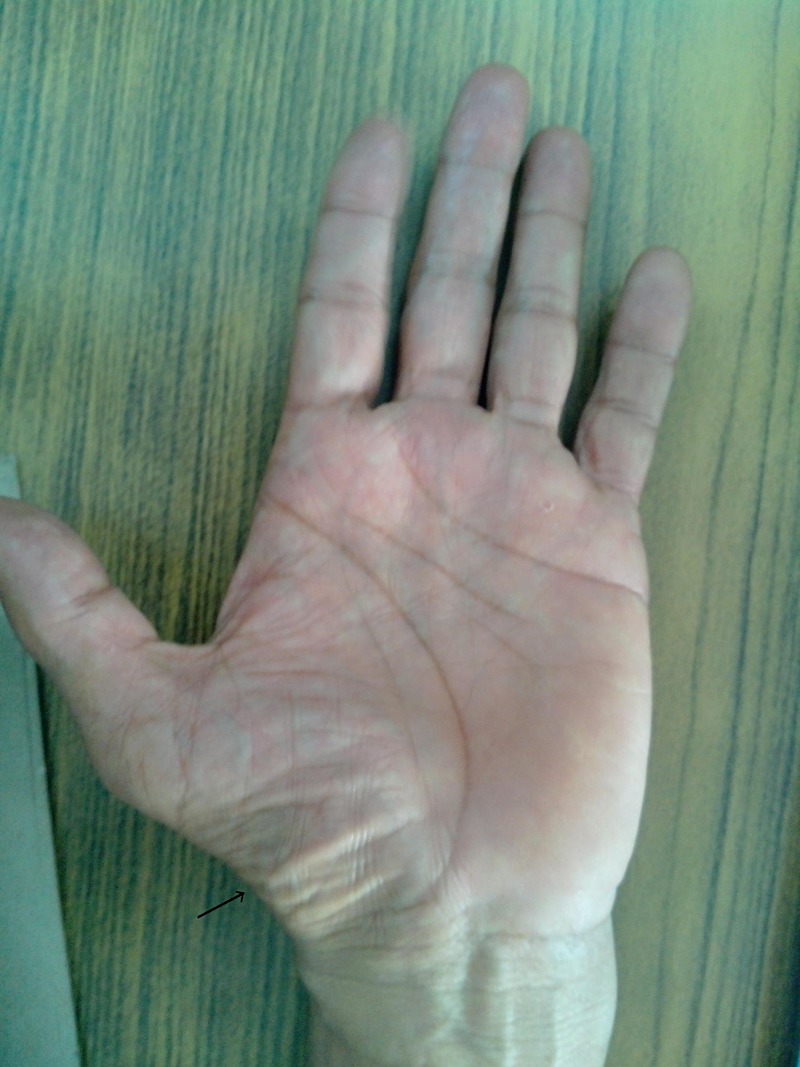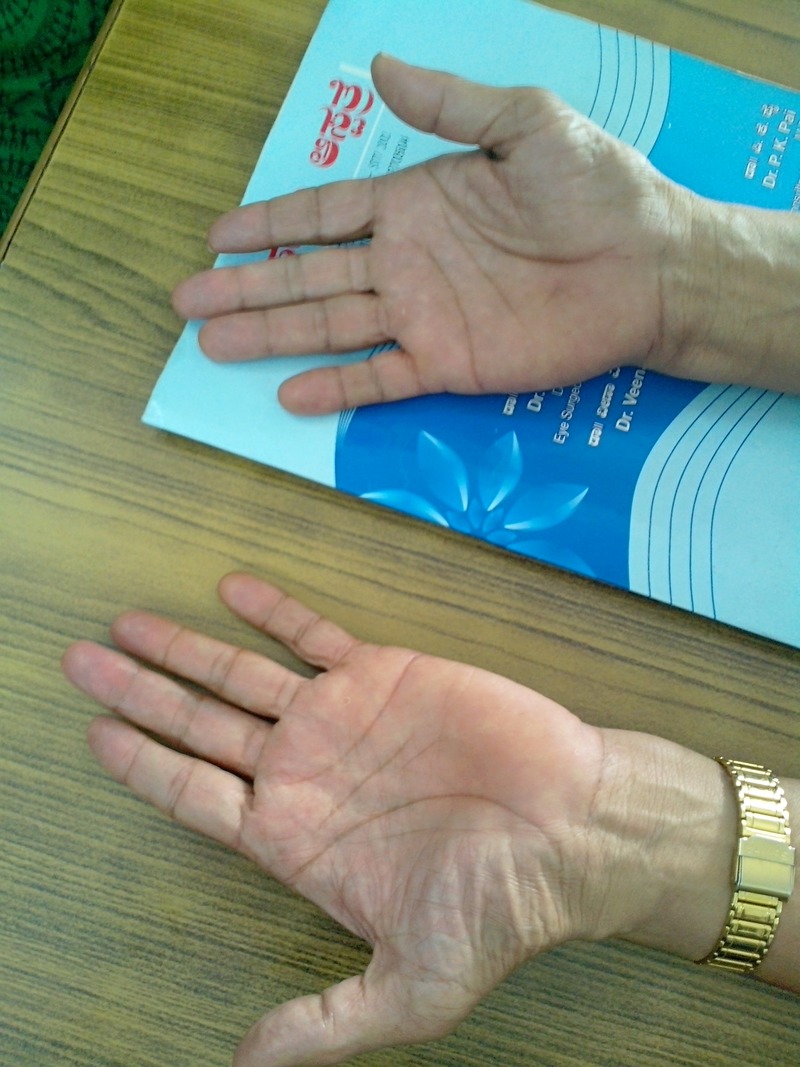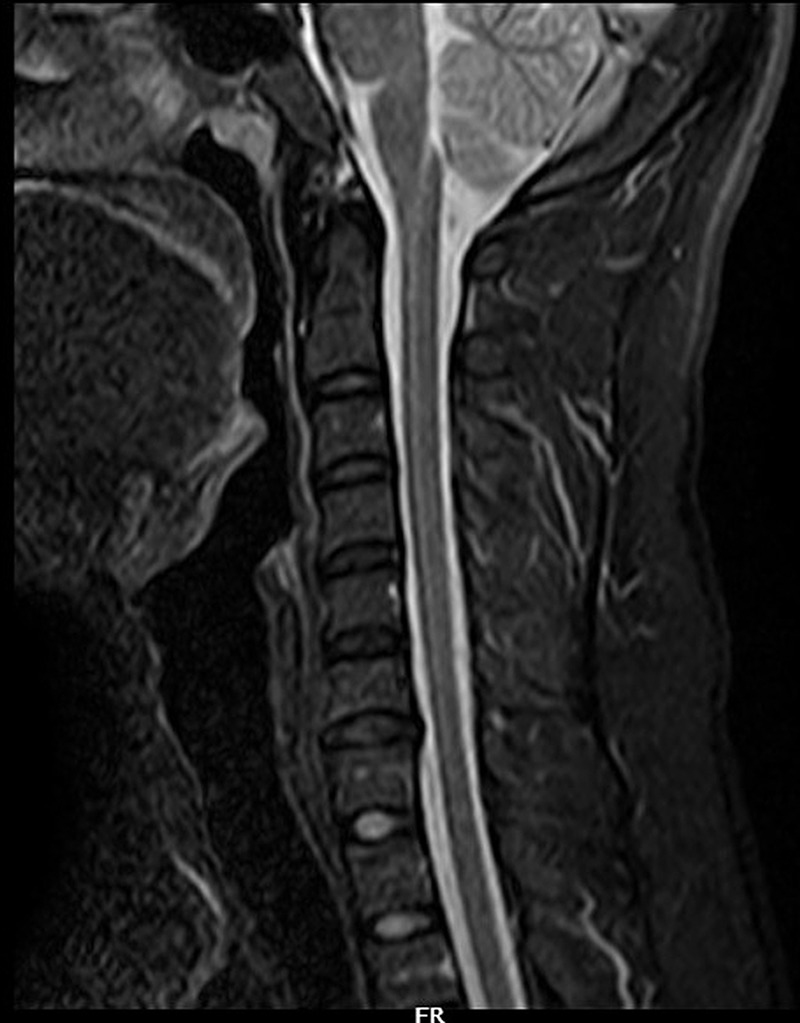Description
A 38-year-old man presented to a hospital with weakness of both hands (right>left) with associated generalised weakness for the past 2 years. The patient initially noticed weakness and thinning of his right hand followed by the left for 2 years, then he noticed a thinning of the arms, right more so that left, and his right thigh for the past 6 months. General examination showed flattening over the right shoulder and wasting of the thenar eminence on both hands with normal hypothenar muscles (figures 1 and 2). Nervous system examination showed tongue fasciculations and significant asymmetrical wasting of abductor pollicis brevis (APB), and first dorsal interossei (FDI) with sparing of abductor digiti minimi (ADM) was noted (figures 1 and 2), but strength was normal in all four limbs with the exception of bilateral weak pincer grip. The patient had wasting of both arms (circumference 10 cm above the olecranon process was 18 and 21 cm for the right and left arms, respectively) and right thigh (circumference 10 cm above tibial tuberosity was 35 cm with left side being 40 cm). The patient had exaggerated reflexes in all four limbs with flexor plantar response and fasciculations most noticeably in deltoid, pectoral and quadriceps muscles suggesting definitive diagnosis of amyotrophic lateral sclerosis (ALS) by EL Escorial criteria. Other cranial nerves, motor, sensory and cerebellar examinations were within normal limits. MRI of the brain and cervical spine were normal, ruling out cervical myelopathy and cervicovertebral junction abnormality (figure 3). Nerve conduction velocity showed compound motor action potential recorded in APB (median nerve at wrist) to be 4.3 mV and ADM (ulnar nerve at wrist) to be 5.0 mV with ratio <1, suggestive of split hand phenomenon of ALS, normal sensory nerve action potential and normal F-wave latency in bilateral median, ulnar and femoral nerves, ruling out the possibility of multifocal motor neuropathy with conduction block. Although hyperexcitability of APB was thought to be a cause for preferential wasting, this was not observed in our patient.1 Electromyography showed evidence of active denervation with fibrillation and fasciculation potentials in bilateral APB, FDI, deltoid and quadriceps muscles. The reason for differential involvement of hand muscles with wasting of thenar muscles (APB and FDI) and sparing of hypothenar muscles (ADM), both supplied by C8-T1 nerve roots, is unclear. Split hand syndrome can be useful to suspect a diagnosis of ALS. As per the latest evidence, cortical and peripheral mechanisms have a role in development of the syndrome.2 That even greater use of the thenar group of muscles would have led to more oxidative stress within them leading to preferential damage may also be a possibility.2 The patient was treated with riluzole 50 mg orally twice a day but did not show much improvement on review after 3 years.
Learning points.
Split hand syndrome is a very rare entity and may be the only manifestation in early amyotrophic lateral sclerosis (ALS) with high specificity.
As there is no definitive therapy for ALS all other possible causes have to be ruled out before diagnosis of ALS.
Figure 1.

Atrophy of thenar muscles (arrow).
Figure 2.

Both hands with split hand syndrome in the patient with amyotrophic lateral sclerosis.
Figure 3.

MRI T2 cervical spine sagittal view showing mild dehydrative disc changes with normal spinal cord.
Footnotes
Contributors: NM and MN drafted the article and reviewed the literature. JE and NV critically reviewed the article prior to submission.
Competing interests: None.
Patient consent: Obtained.
Provenance and peer review: Not commissioned; externally peer reviewed.
References
- 1.Shibuya K, Misawa S, Nasu S, et al. Split hand syndrome in amyotrophic lateral sclerosis: different excitability changes in the thenar and hypothenar motor axons. J Neurol Neurosurg Psychiatry 2013;84:969–72 [DOI] [PubMed] [Google Scholar]
- 2.Eisen A, Kuwabara S. The split hand syndrome in amyotrophic lateral sclerosis. J Neurol Neurosurg Psychiatry 2012;83:399–403 [DOI] [PubMed] [Google Scholar]


